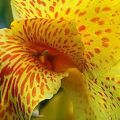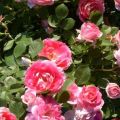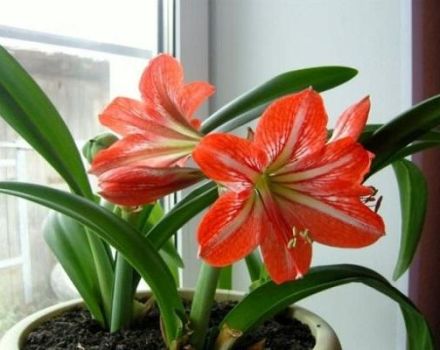Description of 24 varieties and types of statice (kermek), planting and care in the open field
Statica is widely cultivated by experienced and novice gardeners from the countries of the former USSR. The plant is famous for its unpretentious care, it is practically not attacked by pests and diseases. It is often grown by summer residents, since the flower does not require regular watering, loosening and feeding. There are many varieties, but only 24 species are cultivated in the CIS countries. For a successful breeding, you should familiarize yourself with all the intricacies of planting and caring for the statice.
Content
- 1 Description and features
- 2 Flower growing methods
- 3 Features of limonium care
- 4 Types of statics
- 4.1 Ordinary
- 4.2 Flat-leaved or broad-leaved
- 4.3 Gmelin
- 4.4 Tatar
- 4.5 Caspian
- 4.6 Sinuate
- 4.7 Perez
- 4.8 Shimmer
- 4.9 German
- 4.10 Supreme pink
- 4.11 Crimean mix
- 4.12 Blue
- 4.13 Suvorov
- 4.14 Violet
- 4.15 Blue cloud
- 4.16 Bondwell
- 4.17 Confetti
- 4.18 Elegant
- 4.19 Mixed Highbrides
- 4.20 Fortress
- 4.21 Compindi
- 4.22 Petit Bouquet
- 4.23 Mascot
- 4.24 Kermek Sarepta
- 5 Diseases and harmful beetles
- 6 Cutting and drying flowers
- 7 Garden decor with a statice: good advice
Description and features
A statice is a perennial or annual herb. It has large, basal foliage that forms a large rosette. Erect stems from 30 to 90 cm high, there are no leaves on them. The flower is a representative of the Piggy group, there are about 350 of its species. The thickets grow up to 0.5 meters high in almost any place. They have been cultivated since 1600. Semi bushes are grown at home, in a vegetable garden or greenhouse.
Flower cups are five-membered, of various shades:
- white;
- yellow;
- blue;
- bluish;
- pinkish;
- apricot;
- lilac;
- Violet.
Flowers are collected in spikelets, forming scutes or panicles. Pollen starts in July and ends with the first cold snaps, the seeds do not lose their germination for 4-5 years. Dried flowers do not require anxious care, grows like a weed.
The culture is extremely resistant to diseases and harmful beetles, lack of moisture, and adverse weather. She just does not tolerate stagnant water in the rhizome, shade, severe frosts below 20 degrees.
In the middle and northern lane, the flower is grown as an annual. Statice reproduces by self-seeding, blooms profusely.

Flower growing methods
You can breed statice at home or in the open field. Generous, high quality seedlings are obtained only by seed. Vegetative propagation is not recommended, since the rhizome is sensitive, it may not survive transplantation into open soil.
From seed
Growing statice from seeds implies daily airing. After the formation of seedlings, regular watering is required, gentle loosening of the soil around.
Collection from planting material
The seeds are small, oblong, and can be harvested in July. During this period, the statice forms fruits, the parietal seeds are located in them. They are placed in airtight containers and kept dry until spring.
Sowing dates for statice flower
When growing seedlings in a greenhouse, sowing seeds is carried out in the last days of March and until mid-April. The ground should warm up 0.5 meters deep. If we are talking about planting a plant in a room, start sowing at the end of February.
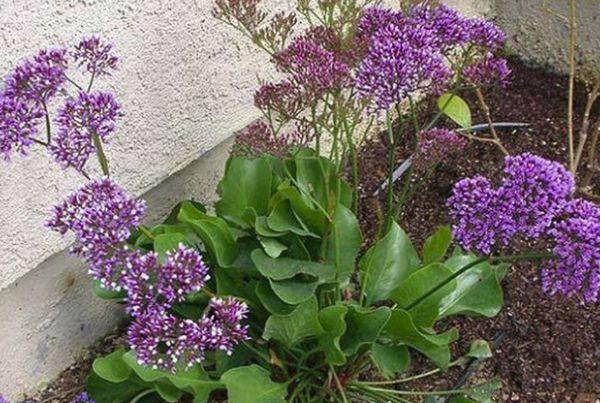
Scheme of planting flowers for seedlings
Seeds should be planted in separate containers, so as not to damage the delicate rhizome later. You can use peat pots. For planting, a special mixture is used, which is previously prepared:
- a bucket of sand is added to the ground;
- sift the soil substrate so that it is cleared of small debris;
- heated in an oven for 2 hours at a temperature of 100 degrees;
- watering the soil with a manganese solution, this will protect future plants from harmful beetles and diseases;
- the ground is slightly moistened with warm water.
Prepared seeds are placed in the soil, laid out in advance in separate containers, sprinkling a little with soil. After that, cover the containers with glass or polyethylene, leave for 10 days in a cool room. For seedlings to form faster, the hoods should be lifted daily, starting up oxygen and checking the soil moisture.
Temperature regime
The room where the seeds are located before germination should be with an air temperature of up to +20. Usually it is a balcony, loggia, basement, greenhouse. The optimum humidity is 50-60%.
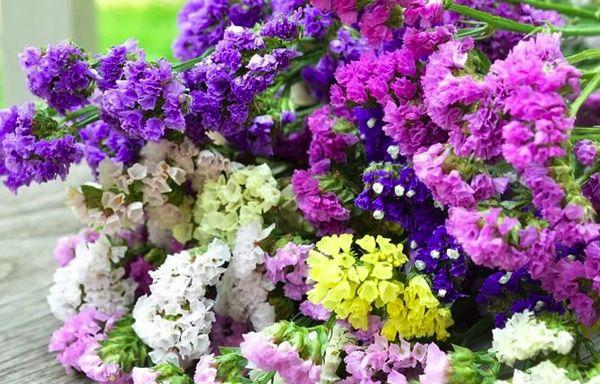
Dive statice
When breeding seedlings in a box, container or small cassettes, after the seedlings have 2 leaves, a pick is carried out. From mid-April, they are tempered by taking them out for 1 hour to the fresh air. When the statitsa spends the whole day on the street, it can be planted in the garden.
Timing
A crop should be planted in the garden at the beginning of June, or at the end of May, when there are no threats of frost. Choose an open place, it can be blown by the wind, culture is not afraid of it. The optimal soil is drained, loamy or sandy, with a neutral acidity level.
Flower Seed Preparation
Soak statice seeds in warm water or growth stimulant solution according to the instructions. Keep in a container for 2-3 hours.
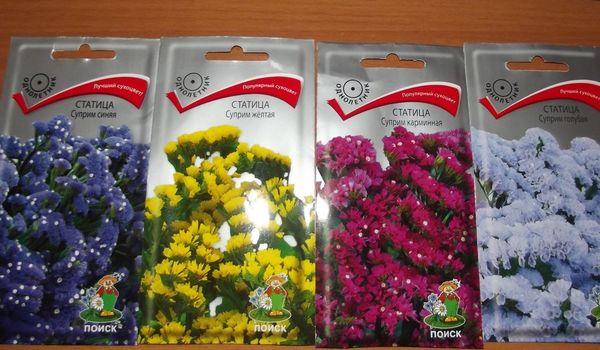
The procedure for planting seedlings statice
The statice is planted according to the steps below.
- Dig holes with the depth of the planting scoop, keeping the distance between the bushes 30 cm.
- They take it out with an earthen lump from the container, trying not to damage it. Dip it in a solution stimulating the formation of rhizomes for half an hour.
- Gravel is poured onto the bottom, a prolonged nutrient is introduced, and sand is sprinkled.
- The earth remaining from the digging is mixed in a separate container with sand and dolomite flour.
- Saplings with soaked rhizomes are placed in a hole, covered with soil mixture.
After planting the flowers, they are watered with settled water. 1 bush accounts for about half a bucket.
Thinning flowers
It is necessary to thin out the aisles of flowers 2-3 times a month, depending on the precipitation. The procedure contributes to the saturation of plants with oxygen, the removal of weeds. You can use a hoe to plow the soil 3-5 cm deep.
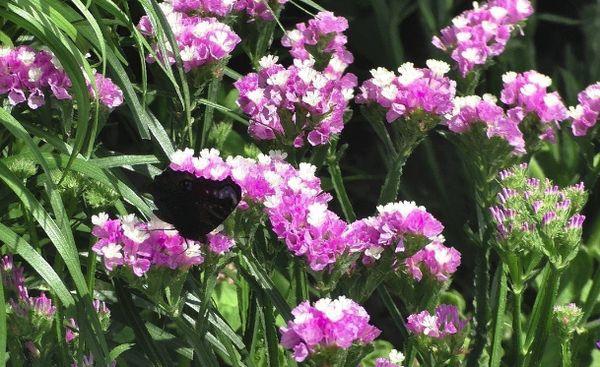
Features of limonium care
It is simple to take care of the statice, it is enough just to water it on time, feed it, prepare it for wintering. Additionally, after pollen, pruning is carried out, removal of wilted inflorescences.
How to water a statice
In the summer, the statice is irrigated once every 1.5 months. Pour standing water under the rhizome after 16.00. One of the watering should be salted liquid, 6 tbsp is taken. salt in 1 bucket.
Top dressing
It is not necessary to feed the statice, but if it grows in poor land, it is better to periodically add nutritional mixtures. The first procedure is carried out with a solution of a mineral substance, 1 week after planting the seedlings in the garden. Then, the culture is fertilized once every 4 weeks. From September the events will be closed.
Preparation for wintering
In regions with an average climate, the statice is grown as an annual, the issue of wintering is removed. If we are talking about the south, it is sheltered before the onset of cold weather in this way:
- cut leaves, stems;
- cover the bushes with straw or dry foliage;
- put burlap on top, press spruce branches to the ground.
The shelter is removed in February, along with the non-woven fabric.
Types of statics
Many varieties of limonium are cultivated, each of which differs in flower buds, sizes. The principle of planting, care is the same.
Ordinary
The statice blooms all summer, with miniature, lilac buds-shields. The height is about 60 cm. The leaf plates are ovoid.
Flat-leaved or broad-leaved
The variety grows up to 75 cm high, with large basal leaves. Baskets are paniculate, spreading, blue-lilac tone.
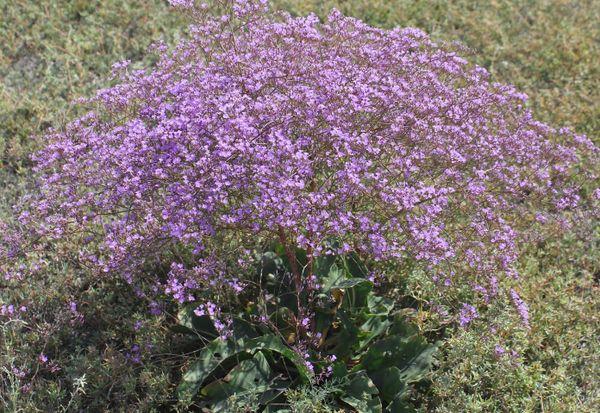
Gmelin
A winter-hardy variety of statice grows up to 50 cm tall. The flowers are blue-violet, paniculate. Basically, large leaves.
Tatar
Perennial reaches a height of 0.3-0.4 meters, resembles a ball in shape. It is called by the people "tumbleweed". The rhizome is powerful, stubble. At the base, leathery, oblong leaves are collected, forming a rosette. Peduncles with inflorescences-spikelets branch out from it. Flowers are small in size, similar in shape to a bell or funnel. They are white with a reddish corolla. Pollen falls in June-July.
Caspian
The heat-loving plant reaches 70 cm in height. The buds are small, pale purple in color. The variety is not grown in the garden in the CIS countries, but only as an indoor or greenhouse flower.
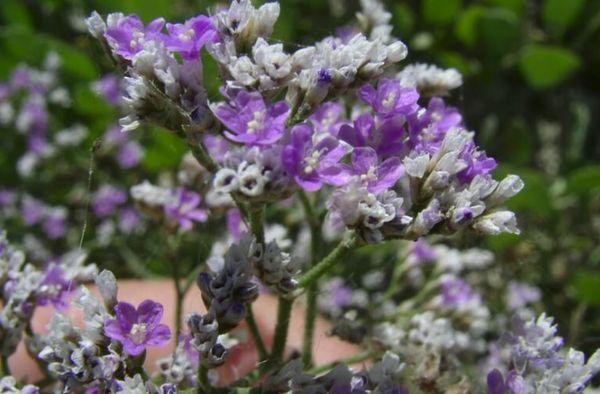
Sinuate
The variety is an annual, its stems reach 60 cm in height. Leaves are basal, elongated, light green. Small buds with a diameter of 1 cm have cups with a spikelet edge. The color is pinkish, white, blue-violet with a light yellow corolla.
Perez
The height of the bushes is about 60 cm. They are densely decorated with purple inflorescences, small petals like lilacs.
Shimmer
The variety grows up to 80 cm high, flowers of various tones. The cups have corrugated edges and are pinkish, purple, white or yellow. The variety is widely used due to its zest in landscape design.
German
The plant is distinguished by its dense, whitish pollen. The bushes look like a snow-white cloud. In the middle of the inflorescences there is a burgundy star. Shields resemble ears of ear. The species is grown preferably by seedling from March to May. Perennial grows 40 cm tall. Pollen falls in mid-June and lasts until the end of July.
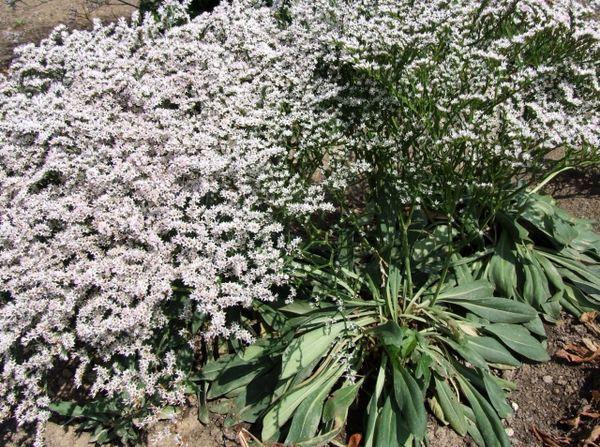
Supreme pink
Stems are straight, powerful, topped with flowers of an ash rose color. The bush grows up to 75 cm high, the buds are funnel-shaped, 1 cm in diameter.
Crimean mix
The height of the flower is 30-80 cm, the stems are erect. Bushes are pinkish, blue, yellow or purple.
Blue
The height of the shrubs is about 75 cm. The flowers are dark blue, the buds are snow-white.
Suvorov
The variety is medium vigorous, growing up to 60 cm tall. The flowers are pinkish and lavender. The petals form elongated, spike-like baskets.
Violet
This is a subspecies of broadleaf limonium, the bush grows up to 75 cm tall. The flowers are deep purple in color, densely cover the stems.
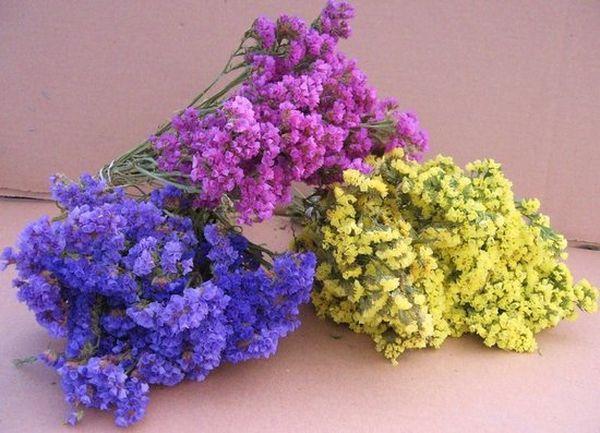
Blue cloud
The broadleaf statice is distinguished by lavender flowers.The bush grows up to 75 cm tall, leaves and stems are light green.
Bondwell
Delicate stems with loose buds consist of large flowers, yellowish or white in color. The variety has been cultivated since 1859. The seeds contain flower mixtures. Bushes grow up to 90 cm tall.
Confetti
Shrubs grow up to 50 cm, emerald stems are erect. Pleiochasium is white-cream, like scutes.
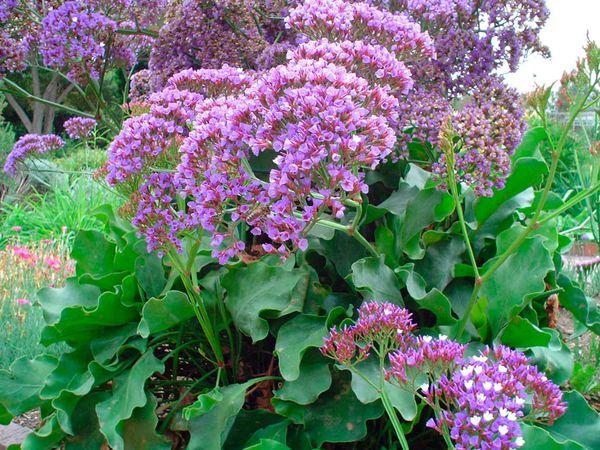
Elegant
The limonium variety grows up to 70 cm in height. Inflorescences are creamy white, similar in shape to a spikelet.
Mixed Highbrides
Bushes grow up to 45 height, spreading stems, emerald. The flowers are purple, white, bluish or pinkish.
Fortress
The height of the bushes is about 80 cm. Pleiochasias are purple, yellow, white, blue or pinkish.
Compindi
The variety is distinguished by bluish, blue, pinkish inflorescences. Bushes reach a height of 0.5 meters.
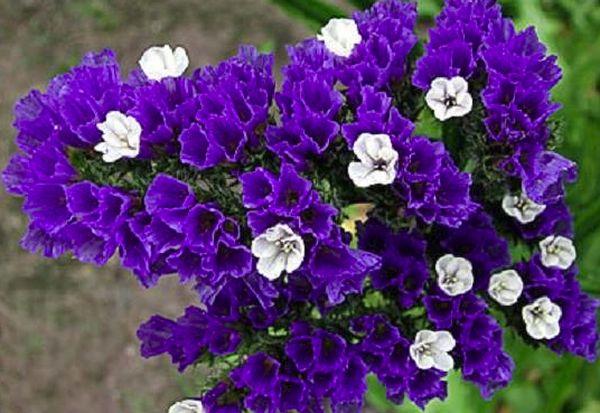
Petit Bouquet
Bushes are small, grow up to 30 cm high. They are covered with flowers of pastel colors: whitish, bluish, lavender, pale pink or cream.
Mascot
The variety is the fruit of domestic selection, bred by the agronomic firm "Poisk". It is an annual, reaching a height of 60 cm, with a two-color petal color. The culture blooms from July to the first frost.
Kermek Sarepta
The statice of Sarepta is famous for its yellow-blue flowers that tightly cover the bush. The plant reaches 50 cm in height, the stems are emerald.
Diseases and harmful beetles
The flower sometimes gets sick with botrytis - rot, when gardeners sin with frequent watering, or a rainy summer falls. Destroy the pest with a fungicidal solution. The statice is also susceptible to mildew, mildew disease. It is recommended to resort to spraying with sulfur-containing formulations. With proper care, pests and diseases should not be attacked.
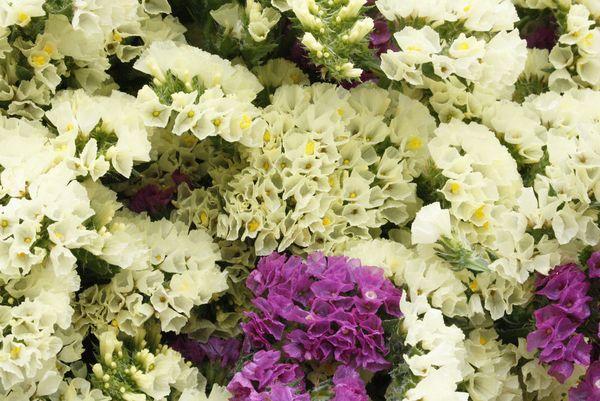
Cutting and drying flowers
When the plant begins to turn yellow or wilt, the leaves, stems and flowers should be cut at ground level and then dried. Dry flower arrangements can be made from them.
To properly dry them, it is worth keeping the specimens upside down, hanging, in a ventilated, dark place until they dry completely. Dried flowers preserve the color saturation of the cups for more than 1 year.
Garden decor with a statice: good advice
Statice will serve as a wonderful garden decor. It is planted in a company with other flowers or several varieties separately. The plant is great for decorating a border, rock garden, it can be planted in front of rosaceous bushes, next to the Aster family.



